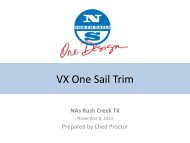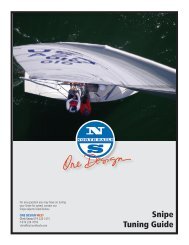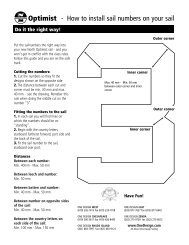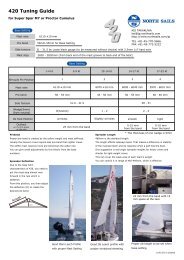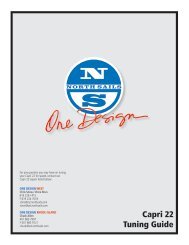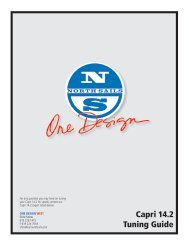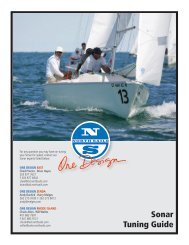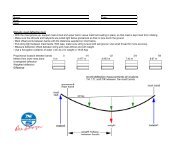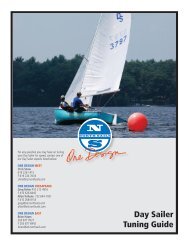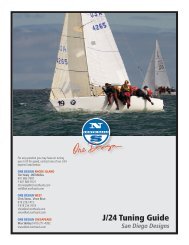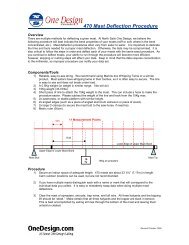Coronado 15 Tuning Guide - North Sails - One Design
Coronado 15 Tuning Guide - North Sails - One Design
Coronado 15 Tuning Guide - North Sails - One Design
Create successful ePaper yourself
Turn your PDF publications into a flip-book with our unique Google optimized e-Paper software.
For any question you may have on tuningyour <strong>Coronado</strong> <strong>15</strong> for speed, contact one ofour <strong>Coronado</strong> <strong>15</strong> experts listed below:ONE DESIGN WESTVince Brun . Chris Snow619 226 14<strong>15</strong>F 619 224 7018chris@od.northsails.comvince@od.northsails.comONE DESIGN RHODE ISLANDChuck Allen401 683 7997F 401 683 9121chuck@od.northsails.comONE DESIGN CHESAPEAKEGreg Fisher410 212-4916F 410 626-8445greg@od.northsails.com<strong>Coronado</strong> <strong>15</strong><strong>Tuning</strong> <strong>Guide</strong>
NORTH SAILS <strong>Coronado</strong> <strong>15</strong><strong>Tuning</strong> <strong>Guide</strong>Proper boat speed depends mostly onconstant and consistent adjustmentsto your rig and sails. The followingmeasurements are those that we havefound to be the fastest settings for younew <strong>North</strong> sails. We have brushed andtested different tuning settings to besure that we have the fastest and easiestmeasurements available. If you have anyquestions, please don’t hesitate to call.MAST BUTT PLACEMENTThe back edge of the stock butt plateshould be 111” from the inside of thetransom when measured along the floorof the boat. The back edge of the mast,when sitting on the forward pin in thestep, should be 114” from the transom.MAST RAKETo measure your mast rake, hoist a metaltape measure on your main halyard, lockit, and hold the tape tight at the top of thetransom in the middle of the transom. Themeasurement is always taken with the jibup, and with all the load on the jib halyardand luff wire. This measurement should be23’ 5” in heavy air and 23’ 6” in light air.RIG TENSION AND SHROUDPLACEMENTWe suggest setting your shrouds sothat the rig will be tight enough thatthe leeward shroud will not go slacksailing upwind until the wind is blowingapproximately 10 mph.An excellent method to determine a moreprecise tension is to use a Loos TensionGauge Model A on the shrouds. Thereading with this smaller tension gaugewill be 18. In light air this reading shouldbe around 200 lbs., in heavy air it shouldbe around 300 lbs. (over <strong>15</strong> knots of wind)SPREADER LENGTH AND CANTYour spreaders (with the standard mast)should be 19” long, with a 6” sweep.Spreader cant will be determined by yourcrew weight. Heavier crews will sails withshorter numbers (spreader tips fartherapart.)MAST PREBENDWith the proper rake, rig tension, andspreader set your mast should developapproximately 1/2” of positive prebendwhen sighted up the back of the mast.MAST BLOCKAt this point, the mast should be blockedat the deck in order to limit mastbend.This will insure that the mast will notoverbend and overflatten the mainsail inheavy winds.NOTE: It is suggested to remove thisblock downwind to avoid any unduestrains on the mast at deck level.MAIN CUNNINGHAM AND JIB CLOTHFor both the main and jib, never applymore luff tension than is necessary tojust barely remove the wrinkles. Mosttimes it is actually better to leave a hintof horizontal wrinkles in the lower 1/4 ofthe luff of your main and jib to be sure youhaven’t pulled too tight.JIB LEAD TRIMLINEYour <strong>North</strong> jib is built with a “trimline”penciled in from the clew grommet outtowards the body of the sail. This isthe most accurate check in determiningproper jib lead position. When the jiblead is positioned properly, your jib sheetshould appear as an exact extension ofthe trimline. At this point both telltales,tip and bottom, should break evenly as theboat is luffed into the wind.C<strong>15</strong>In heavy winds, when the boat isoverpowered, move your jib leads aft asmuch as 2” at which point your jib sheetwill angle slightly aft of the trimline andyour jib will become flatter up top with theleech more open.JIB SHEET TRIMUnfortunately, there is no easy guide fortrimming the jib sheet. We are lookingfor a parallel slot between the exit of thejib and the entry of the main. The guidewhich has been very successful is that ofimagining a middle batten on the jib atmid-leech. This “batten” should be setparallel to the centerline of the boat whichwill make the upper half of the jib leechtwist outboard slightly, and the lower halftwist inboard slightly. In light air, 1-2” offshroud base, in medium air the foot shouldbe curled to just touch the chainplate andin heavy air there should be a horizontalcrease appearing along foot.It is important to be careful not to overtrimthe jib and hook the imaginary battentighter than parallel with the centerline ofthe boat. It seems that 90% of the boatspeed problems experienced are due tofaulty jib sheet trim.MAINSHEET TRIMTrim the main through use of themainsheet and the boomvang so that thelast 1/3 of the upper batten is parallel tothe boom (sighted from under the boom,looking up the sail.) In light winds it willbe impossible to keep the upper battenfrom hooking slightly to windward due tothe large roach of the C-<strong>15</strong> main. In theseconditions set the upper batten parallelto the centerline of the boat (instead ofVisit our web site at www.<strong>One</strong><strong>Design</strong>.com for the latest <strong>Coronado</strong> <strong>15</strong> news and tuning tips.© 2007 <strong>North</strong> <strong>Sails</strong> <strong>One</strong> <strong>Design</strong>. All rights reserved.1



